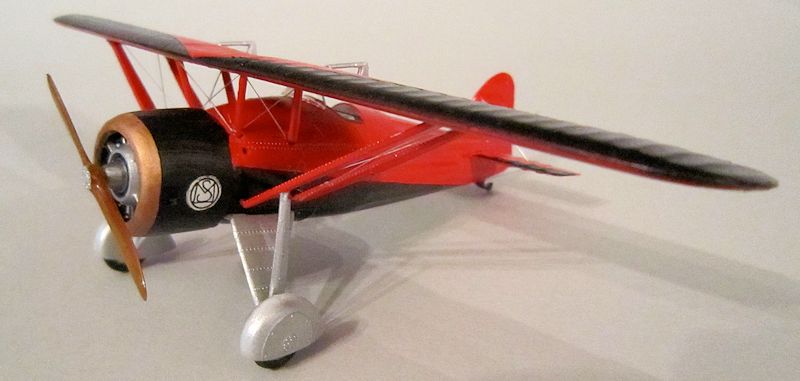
Smer/Heller 1/72 MS.225
| KIT #: | 0838 |
| PRICE: | About £5 |
| DECALS: | Two options |
| REVIEWER: | Chris Peachment |
| NOTES: | As flown by Michel Detroyat |

| HISTORY |
This particular conversion of the MS 225 came about after my friend
Angus MacKinnon gave me the book Les Rois du Parasol, Morane-Saulnier
1918-1968, which is published in French by Revue de L'Aviation Icare.
On reflection, Icarus does not seem an auspicious name for a publisher
of aviation matters. You will recall that Icarus was the the ancient
Greek who, in attempt to flee the island of Crete, flew too near the
sun, which melted the wax holding his feathers on, and he plunged to his
doom into the sea. Just south of the island of Samos, his resting place
is still known as the Icarean sea.
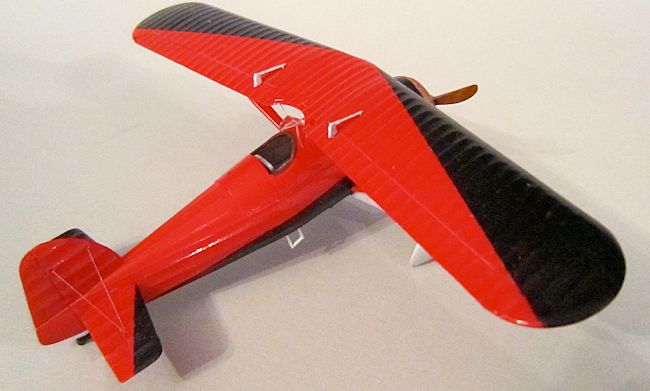 Those
modellers whose French is as rusty as mine can take heart. The book is
mainly composed of large well detailed pictures, and the technical
French captions are easily guessed at by anyone with a working knowledge
of aeronautical terms.
Those
modellers whose French is as rusty as mine can take heart. The book is
mainly composed of large well detailed pictures, and the technical
French captions are easily guessed at by anyone with a working knowledge
of aeronautical terms.
The legendary Michel Detroyat was chief pilot for Morane, and is
described in the book as a “voltigeur incomparable”. He used this
modified MS 225 as his personal mount for stunt flying and also for
taking part in the famous aerobatics contest of 1934, which he lost to
the German pilot Gerhard Fieseler, later famous as a designer of
aircraft such as the low-speed Storch.
There is also footage on Youtube of him teaching Bao Dai, the last
emperor of Vietnam, or Annam as it then was, to fly. Bao Dai can be seen
smiling happily in his white overalls as Detroyat lifts him out of the
cockpit.
You can find good descriptions of the Morane fighter elsewhere on this
website. The only real differences that Detroyat's machine had from the
fighter is the removal of the twin gun armament, and his personal paint
scheme. I had an old Morane sitting on the shelf of doom, getting dusty
and awaiting some further use. I was about to start dismantling it, but
it was saved from the boneyard by my discovering the Smer reboxing at a
model shop, and I am glad that I bought it because you get a very nice
new decal sheet for the spares box. It would cost you as much as the kit
to buy it separately . So the old Heller Morane continues to sit there
in trepidation awaiting a different fate. Any suggestions would be
gratefully received.
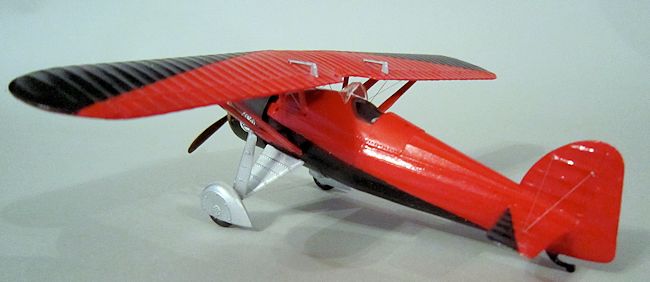 I
am fond of parasol fighters, they look so dainty.
Although a very high wing on an aircraft will make it naturally
very stable, a characteristic not always desirable in a fighter, which
ought to have some instability to quicken its manoeuvres. However, if
you look on Youtube you will find some old grainy footage of that famous
1934 Aerobatics contest, and it is clear that Detroyat could throw it
around the sky with hair raising abandon. There is one sequence of him
doing the “Falling Leaf” move, which makes me airsick just to look at
it.
I
am fond of parasol fighters, they look so dainty.
Although a very high wing on an aircraft will make it naturally
very stable, a characteristic not always desirable in a fighter, which
ought to have some instability to quicken its manoeuvres. However, if
you look on Youtube you will find some old grainy footage of that famous
1934 Aerobatics contest, and it is clear that Detroyat could throw it
around the sky with hair raising abandon. There is one sequence of him
doing the “Falling Leaf” move, which makes me airsick just to look at
it.
You should also note that Detroyat also used the two seater MS 230
trainer as a personal mount. It has a wider chord wing, a deeper engine
cowl, and he modified it to have one cockpit, and a paint scheme of red
and black but with a large white arrow down the side of the fuselage.
Heller also do a kit of this aircraft, and it would make a good choice
for a slightly harder modification. The scratch builder Gabriel Stern
has done both, and very nice they look too together.
| THE KIT |
Heller kits were good for their time, and
this one still stands up well. The only glaring error I could see was that
the underside of the wing has no aileron line, a mistake which is easy to
rectify.
| CONSTRUCTION |
I used the standard cockpit, although
there is some evidence that Detroyat lightened it by cutting away some of
the excess flooring. It isn't worth doing as it would be invisible. More
pedantic modellers than I could go to work with extra stringers and
throttles and such, but my life is in its autumn now, and time
 has
become too valuable to waste on details which won't be seen without the aid
of a flashlight and dental mirror. Neither of which I carry with me when
surveying my models. The
interior was painted aluminium, with the seat in the same colour.
has
become too valuable to waste on details which won't be seen without the aid
of a flashlight and dental mirror. Neither of which I carry with me when
surveying my models. The
interior was painted aluminium, with the seat in the same colour.
| COLORS & MARKINGS |
I kept the
fuselage separate from the wing, struts undercarriage and tailplanes. I
blasted on the red first, and tried using some of the new Revell Ferrari red
aerosol cans. It is a nice shade all right, though the cans are small and I
would guess lacking in
propellant, as orange peel and running resulted. Take note, if using, to
make your sweeps across the aircraft quick and light. This will save you a
lot of re-sanding and cursing.
Alternatively use my usual favourite, which is Tamiya red X-7, a lovely
shade.
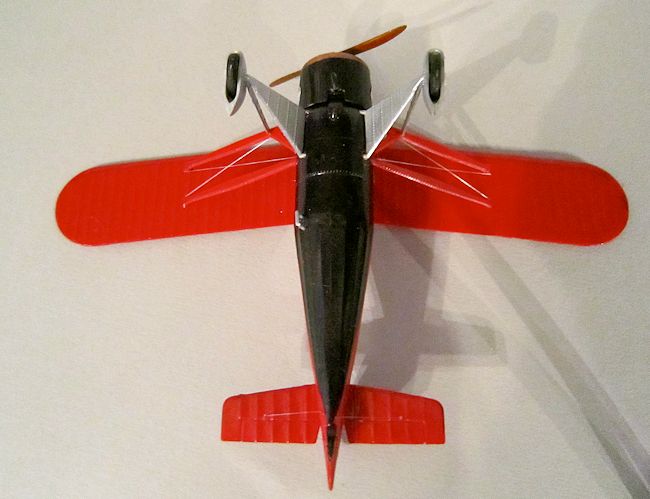
| FINAL CONSTRUCTION |
The engine and oil cooler can be duly
painted in the style of your choice. I favour black dry-brushed with
gunmetal, though others reverse the process. They fit neatly into the cowl.
After I had finished I found some pictures suggesting that the oil cooler
ring, behind the propellor, was perforated with small s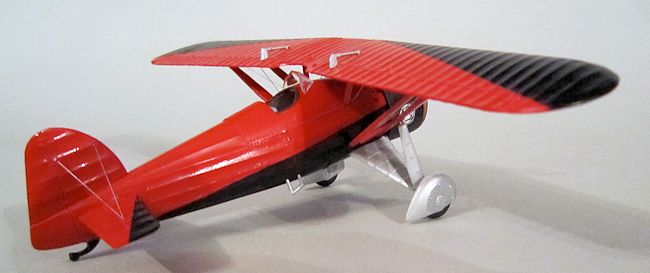 quare
air intakes around its perimeter. You might like to consider that if you
have tiny fingers, good sight and a more pedantic frame of mind than I.
The propellor needs sanding a little, and then painting in dark brown
with a coat of clear orange and a silver hub.
quare
air intakes around its perimeter. You might like to consider that if you
have tiny fingers, good sight and a more pedantic frame of mind than I.
The propellor needs sanding a little, and then painting in dark brown
with a coat of clear orange and a silver hub.
| CONCLUSIONS |
Voila. You have a familiar fighter aircraft from the golden age of aviation, but
in a racer's markings. And you also have an hommage to a great pilot, Michel
Detroyat, who died in his bed in 1956.
There is an old joke among pilots which goes “I don't want to be a great
pilot, I want to be an old pilot.” In fact he was only 51 when he died of a
stroke, but in an era of danger, when all flights were a throw of the dice, he
was a survivor.
| REFERENCES |
http://aircollection.pagesperso-orange.fr/detroyat.htm
http://m-m.meric.perso.sfr.fr/pages_site/aviation.htm
http://www.youtube.c...h?v=LFl0pGVWmwk
http://micheldetroyat.blogspot.co.uk/2010/01/paris-1934-coupe-mondiale-dacrobatie_30.html
January 2014
Copyright ModelingMadness.com. All rights reserved. No reproduction in part or in whole without express permission from the editor.
If you would like your product reviewed fairly and fairly quickly, please contact the editor or see other details in the Note to Contributors.
Back to the Review Index Page 2024